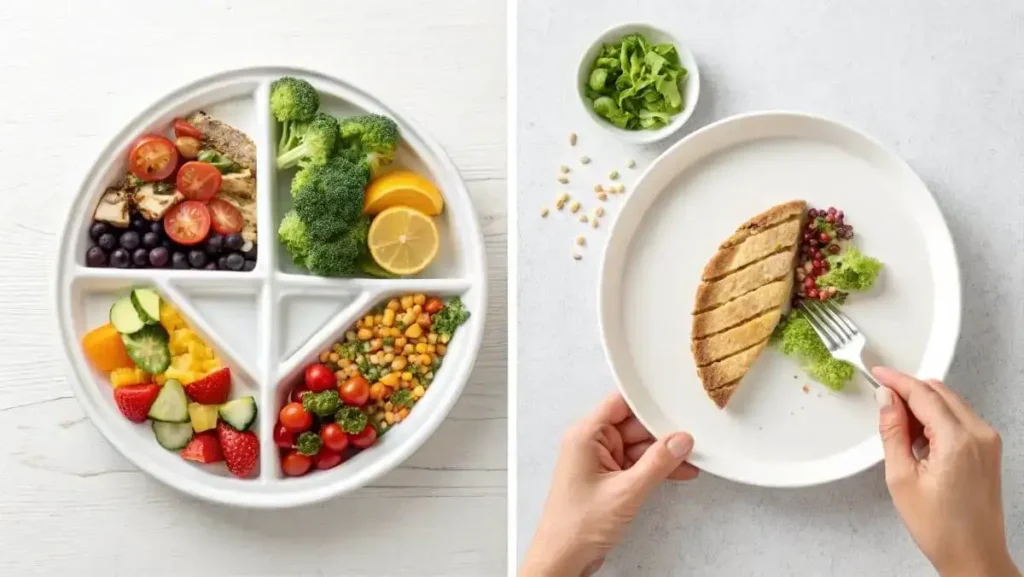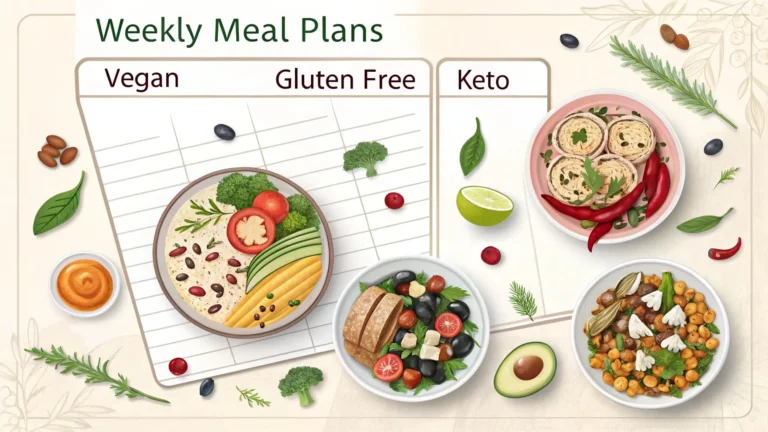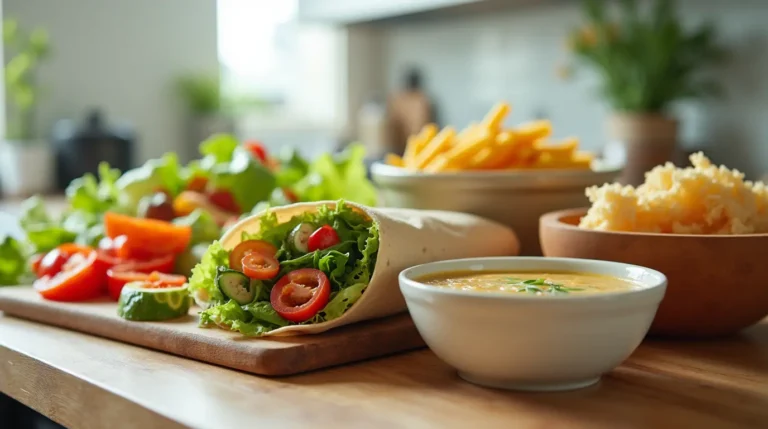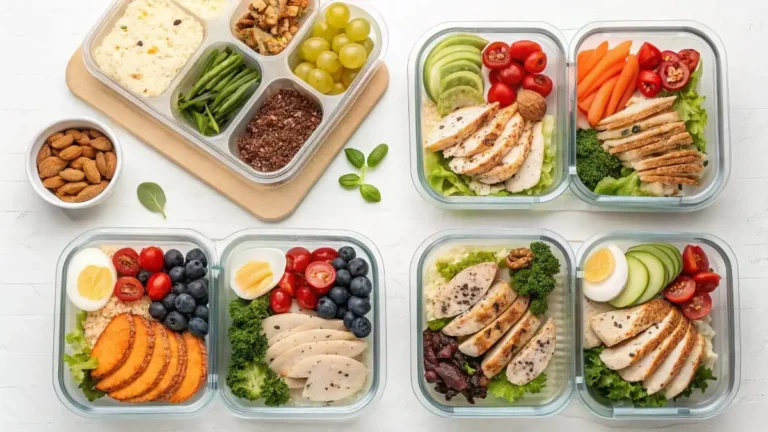Save Time & Money: Simple Weekly Meal Plans You’ll Love
Weeknights feeling like a whirlwind of rushed dinners and takeout menus? Wallet feeling a little lighter than you’d like after grocery shopping? You’re not alone! For busy families, juggling work, school, and activities, and still trying to get a healthy meal on the table can feel like an impossible feat. But what if I told you there’s a simple solution that can revolutionize your weeknights, save you money, and bring more joy back to dinnertime? Welcome to the world of Simple Weekly Meal Plans, You’ll Love it! This isn’t about complicated meal prep marathons or restrictive diets; it’s about creating a realistic, stress-free, and budget-friendly system to feed your family delicious and healthy meals, week after week.
Imagine reclaiming your evenings, saving money on groceries, and enjoying family dinnertime again – all thanks to the power of simple meal planning. If you’re interested in understanding the bigger picture of balanced eating and how meal planning fits in, be sure to check out our comprehensive Ultimate Meal Plan Balance Guide 2025 for a holistic approach to healthy eating.
Table of Contents
Why Weekly Meal Plans are a Game-Changer for Busy Families in 2025
Why are weekly meal plans such a game-changer for busy families? Let’s explore the top reasons why incorporating meal planning into your routine can transform your weeknights and your family’s well-being in 2025.
Time is Money (Especially for Busy Families!): Reclaim Your Weeknights
Time is the most valuable currency for busy families. Weekly meal plans are like a time machine, allowing you to reclaim your precious weeknights and break free from the dinnertime rush. Think about it: how much time do you currently spend each week:
- Wondering “What’s for Dinner?” Eliminate that daily mental scramble and decision fatigue.
- Running to the Grocery Store Last-Minute? Avoid frantic trips for forgotten ingredients.
- Cooking Dinner Under Pressure? Reduce rushed and stressful cooking sessions.
- Cleaning Up a Kitchen Disaster After a Hectic Meal? Minimize kitchen chaos and streamline cleanup.
Weekly meal plans streamline the entire dinnertime process, from planning to shopping to cooking, freeing up valuable hours each week that you can spend on more enjoyable activities with your family – whether it’s helping with homework, playing games, or simply relaxing and connecting after a busy day.
Budget-Friendly Eating: Stop Food Waste & Save Money on Groceries
Beyond time savings, weekly meal plans are a powerful tool for budget-friendly eating and can significantly reduce your grocery bills and food waste. Consider the financial benefits:
- Say Goodbye to Takeout Temptation: When you have a meal plan in place and ingredients on hand, you’re far less likely to give in to the convenience (and expense!) of takeout or restaurant meals on busy weeknights.
- Minimize Impulse Buys at the Grocery Store: A focused grocery list based on your meal plan helps you stick to your intended purchases and avoid those tempting but often unnecessary impulse buys that inflate your grocery bill.
- Reduce Food Spoilage and Waste: Meal planning helps you use up the groceries you buy before they spoil. By planning meals around specific ingredients, you’re less likely to have produce languishing in the refrigerator or pantry staples going unused, directly reducing food waste and saving you money.
- Strategic Use of Sales and Coupons: With a meal plan, you can proactively plan your meals around grocery store sales and coupons, further maximizing your budget and getting the most value for your money.
Healthier Eating Made Easy: Balanced Meals Without the Weekday Stress
Weekly meal plans are not just about convenience and cost savings; they are also a secret weapon for making healthier eating easier and more consistent for your family, even amidst busy schedules. Meal planning empowers you to:
- Consciously Incorporate Nutritious Foods: You can intentionally plan meals that include a variety of food groups – vegetables, fruits, lean proteins, and whole grains – ensuring your family is getting balanced nutrition throughout the week.
- Control Ingredients and Portion Sizes: Cooking at home based on a meal plan gives you complete control over the ingredients you use and portion sizes. You can choose healthier cooking methods, use less salt and unhealthy fats, and avoid hidden sugars and processed ingredients often found in takeout and pre-made meals.
- Make Healthier Choices More Convenient: With a meal plan and prepped ingredients, healthy eating becomes the easy option. You’re more likely to cook a nutritious meal when you have a plan in place and ingredients ready to go, rather than reaching for less healthy convenience foods when you’re tired and hungry.
- Reduce Stress-Related Unhealthy Eating: Meal planning helps to minimize the stress and chaos around dinnertime, which can often trigger unhealthy eating habits like emotional eating or impulsive takeout orders. A planned and organized approach to meals promotes a calmer and more mindful eating environment for the whole family.
Family Harmony at Dinnertime: Less Mealtime Battles, More Family Time
Dinnertime can often become a battleground in busy families, with picky eaters, conflicting preferences, and the constant struggle to get everyone to the table on time. Weekly meal plans can foster family harmony at dinnertime and transform mealtime into a more enjoyable and connecting experience:
- Reduces Mealtime Decision Stress: Having a meal plan eliminates the daily dinnertime debate and the endless question of “What should we eat?”. This reduces stress and conflict around mealtime decisions, making dinners more peaceful for everyone.
- Increases Predictability and Routine: Children, especially, often thrive on routine and predictability. Knowing what’s for dinner each night can create a sense of calm and structure around mealtimes, reducing anxiety and mealtime battles.
- Opportunity for Family Input & Collaboration: Involve your family in the meal planning process! Ask for their input on recipe ideas, favorite meals, and theme night suggestions. This makes everyone feel more invested in the meal plan and increases the likelihood of cooperation and enjoyment at dinnertime.
- More Quality Family Time: By taking the stress out of meal preparation and decision-making, weekly meal plans free up valuable time and mental energy, allowing families to focus on what truly matters: enjoying each other’s company and connecting over a shared meal. Dinnertime becomes less about the logistics of food and more about quality family time.
Beyond the Takeout Menu: Taking Control of Your Family’s Food Choices
Are you tired of relying on takeout or restaurants for weeknight dinners? Weekly meal plans empower you to take back control of your family’s food choices and break free from the takeout cycle. By planning and preparing meals at home, you:
- Control Ingredients and Quality: You have complete control over the ingredients you use, ensuring you’re feeding your family wholesome, high-quality foods without hidden additives, excessive sodium, or unhealthy fats often found in takeout and restaurant meals.
- Customize for Dietary Needs and Allergies: Meal planning makes it easy to adapt recipes to accommodate your family’s specific dietary needs, allergies, and preferences. Whether you need gluten-free, dairy-free, vegetarian, low-carb, or picky-eater-friendly meals, you have the flexibility to customize your meal plans accordingly.
- Develop Culinary Skills and Confidence: Meal planning encourages you to cook more at home, which in turn helps you develop your culinary skills and kitchen confidence over time. As you become more comfortable in the kitchen, you’ll feel empowered to create healthy and delicious meals for your family.
- Create Healthier Eating Habits for the Long Term: Meal planning promotes consistent home cooking and mindful food choices, which are key for establishing long-term healthy eating habits for the whole family. You’re not just feeding your family dinner; you’re cultivating a healthier relationship with food and building lifelong healthy habits.
Your Guide to Creating Simple Weekly Meal Plans You’ll Use
Ready to ditch the dinnertime stress and start saving time and money with meal planning? Let’s break down the process into five simple, actionable steps to set you up for success.
The “Simple” Philosophy: Keeping Meal Planning Realistic & Doable for Busy Lives
The secret to successful weekly meal planning for busy families is to embrace the “simple” philosophy. Remember, meal planning should reduce stress, not add to it! Keep these principles in mind:
- Keep it Realistic: Be honest about your time, energy levels, and cooking skills. Choose recipes that are truly quick and easy for you to prepare on busy weeknights. Don’t aim for elaborate gourmet meals every night – simple and satisfying is key.
- Start Small and Build Gradually: Don’t try to plan every single meal and snack for the entire week right away, especially when you’re first starting. Begin by planning just 3-4 dinners per week. Once you get comfortable with that, you can gradually add more meals and snacks to your weekly plan as you build confidence and get into the routine.
- Embrace Flexibility: Life is unpredictable, and schedules change. Don’t strive for rigid perfection. Build flexibility into your meal plan. Plan for “flex nights” (takeout or leftovers), be ready to swap meals around if needed, and don’t feel guilty if you deviate from the plan occasionally. The goal is to create a helpful guide, not a strict set of rules.
- Focus on Progress, Not Perfection: Meal planning is a journey, not a destination. Focus on making consistent progress towards your goals, not achieving perfect meal plans every single week. Celebrate small victories, learn from weeks that didn’t go as planned, and keep refining your approach over time. The most important thing is to get started and keep moving forward!
Key Elements of a Time & Money-Saving Weekly Meal Plan
To create weekly meal plans that truly save you time and money, incorporate these essential elements into your planning process:
Repeat Meals & Recipes: Embrace Familiar Favorites & Reduce Decision Fatigue
- Identify Family Favorites: Make a list of 5-10 family-favorite dinner recipes that you know are relatively easy to make and that everyone enjoys. These will be the cornerstones of your weekly meal plans.
- Build a Recipe Rotation: Create a rotating schedule of these family-favorite meals. For example, rotate through 5-7 different dinners each week, repeating them every 2-3 weeks. This provides variety while still keeping meal planning simple and familiar.
- Theme Nights for Variety within Rotation: Even with repeated meals, you can add variety by incorporating theme nights. For example, “Taco Tuesday” can be a consistent theme, but you can rotate different taco fillings each week (ground beef tacos one week, chicken tacos the next, fish tacos after that, etc.).
Batch Cooking & Meal Prep: Weekends are Your Secret Weapon
- Choose Batch-Friendly Components: When selecting recipes for your meal plan, prioritize recipes that have components that can be batch-cooked or prepped ahead of time on the weekend. Soups, stews, chili, roasted vegetables, cooked grains, and protein sources like grilled chicken or baked tofu are all excellent for batch cooking and meal prep.
- Weekend Prep Session: Dedicate a few hours on the weekend to a meal prep session. Focus on prepping components rather than entire meals. Cook grains like quinoa or rice, roast a big batch of vegetables, grill chicken breasts or tofu, make a batch of soup or chili, and prepare salad dressings and sauces.
- Store Components Strategically: Store your prepped components in airtight containers in the refrigerator, clearly labeled with the date and contents. This makes assembling meals during the week incredibly quick and easy.
- Utilize Leftovers Creatively: Plan to use leftovers strategically throughout the week. Leftover roasted chicken can be used in salads, wraps, or quick skillet meals. Leftover quinoa can be added to salads, bowls, or as a side dish. Leftover soup or chili makes for easy lunches.
Pantry Staples & Smart Grocery Shopping: Stocking Up Strategically
- Create a Pantry Staples List: Develop a comprehensive pantry staples list of non-perishable items you use frequently in your cooking. (Refer to the pantry staples list provided earlier in this guide for inspiration). Keep this list handy for easy grocery shopping reference.
- Regular Pantry Inventory: Periodically take inventory of your pantry staples to see what you already have on hand before creating your grocery list each week. This helps prevent overbuying and ensures you use up what you already have.
- Shop Sales & Stock Up: Take advantage of grocery store sales and coupons. When pantry staples you use frequently are on sale, stock up to save money in the long run. Non-perishable items like canned goods, grains, pasta, spices, and frozen vegetables are great items to buy in bulk when they are discounted.
- Organize Your Pantry & Fridge for Visibility: A well-organized pantry and refrigerator make meal planning and grocery shopping much more efficient. Organize items by category (canned goods together, grains together, spices together) so you can easily see what you have on hand and find ingredients quickly when cooking. Clear containers and labels can be helpful for pantry organization.
Theme Nights & Recipe Categories: Organizing Your Week for Variety
- Establish Theme Nights: Assigning themes to different nights of the week is a fun and effective way to add variety to your meal plans and simplify recipe selection. Theme nights provide a framework for your meal planning and prevent you from having to start from scratch each week.
- Theme Night Examples:
- Meatless Monday: Vegetarian or vegan meals to start the week off healthy and budget-friendly.
- Taco Tuesday: Mexican-inspired meals, tacos, burritos, fajitas – endlessly customizable and family-friendly.
- Pasta Night Wednesday: Pasta dishes – quick and comforting, can be paired with vegetables and protein for balance.
- Soup & Salad Thursday: Lighter meals like soups, salads, or sandwich-and-soup combos for a mid-week reset.
- Pizza Friday: Homemade pizza night – fun for the whole family, customizable toppings, and a great way to use up leftover vegetables.
- Grill Night Saturday: Grilling (weather permitting) for flavorful and easy-cleanup meals. Grilled chicken, fish, or veggie skewers are great options.
- Slow Cooker Sunday: Slow cooker meals are perfect for Sundays – minimal prep, hands-off cooking, and a hearty meal ready for Sunday dinner and leftovers for the week ahead.
- Categorize Your Recipes: Organize your recipe collection into categories (Soups & Stews, Pasta Dishes, Sheet Pan Dinners, Vegetarian Mains, Chicken Recipes, Beef Recipes, Fish Recipes, etc.). This makes it much easier to find recipes that fit your theme nights and ensures you are incorporating variety from different food groups into your weekly meal plans.

Sample Simple Weekly Meal Plans You’ll Love: Inspiration for Busy Families
Ready to put these meal-planning strategies into action? Here are three sample weekly meal plans designed to provide inspiration and templates that you can adapt for your own busy family. Remember, these are just examples – feel free to swap out recipes, adjust portion sizes, and customize them to suit your family’s preferences and dietary needs!
Sample Meal Plan #1: “Quick & Easy Weeknight Dinners”
30-Minute Meals or Less!
This sample meal plan is all about speed and convenience, featuring dinners that are ready in 30 minutes or less – perfect for those hectic weeknights when time is tight.
7-Day Family Meal Plan
Sample Meal Plan #1 – Quick & Easy Weeknight Dinners
| Day | Dinner Recipe | Estimated Prep Time | Estimated Cook Time | Notes |
| Monday | Sheet Pan Lemon Herb Chicken & Veggies | 15 minutes | 25 minutes | One-pan, minimal cleanup, uses pre-cut veggies for speed |
| Tuesday | 30-Minute Ground Beef Tacos | 15 minutes | 15 minutes | Customizable toppings, family favorite, use pre-shredded cheese & salsa |
| Wednesday | One-Pot Creamy Tomato Pasta | 10 minutes | 20 minutes | Pantry-friendly, vegetarian, pasta cooks directly in sauce, minimal prep |
| Thursday | Quick Shrimp Scampi with Linguine | 10 minutes | 15 minutes | Uses pre-cooked shrimp for speed, garlic bread from store-bought baguette |
| Friday | Homemade Pizza Night (using pre-made dough) | 20 minutes | 20 minutes | Pre-made dough saves tons of time, let everyone customize their toppings |
| Saturday | Grilled Chicken & Veggie Skewers | 20 minutes | 15 minutes | Marinate chicken quickly while prepping veggies, grilling is fast |
| Sunday | Slow Cooker Pulled Pork Sandwiches | 10 minutes prep | 6-8 hours slow cook | Slow cooker does all the work, minimal active time, use pre-made coleslaw |
Recipe Spotlight for Sample Meal Plan #1:

Recipe Spotlight: Sheet Pan Lemon Herb Chicken & Veggies
Sheet Pan Lemon Herb Chicken & Veggies is a perfect example of a weeknight dinner win! It showcases how you can create a healthy, flavorful, and satisfying meal with minimal effort and maximum time savings. The beauty of sheet pan dinners lies in their simplicity – everything cooks together on one pan, drastically reducing both prep time and cleanup. This recipe utilizes pre-cut vegetables to further speed up preparation and relies on simple seasonings like lemon, herbs, salt, and pepper to create delicious flavor without fuss. For busy families, sheet pan dinners like this are a game-changer, making healthy weeknight meals feel truly achievable and stress-free.
Sample Meal Plan #2: “Budget-Friendly Family Favorites”
Delicious Meals on a Dime!
This sample meal plan proves that eating well as a family doesn’t have to break the bank. It focuses on budget-friendly recipes that utilize economical ingredients, pantry staples, and smart cooking strategies to create delicious meals without overspending.
7-Day Sample Meal Plan
Sample Weekly Meal Plan Ideas #2 – Budget-Friendly Family Favorites
| Day | Dinner Recipe | Estimated Cost per Serving | Notes |
| Monday | Lentil Soup & Crusty Bread | $1.50 | Vegetarian, hearty, uses budget-friendly lentils, and day-old bread is great! |
| Tuesday | Baked Potato Bar with Chili Toppings | $2.00 | Potatoes are incredibly economical, canned chili (or homemade budget chili) |
| Wednesday | Spaghetti with Meat Sauce (using ground beef) | $2.50 | Spaghetti is cheap pasta, ground beef stretches to feed many |
| Thursday | Chicken Stir-Fry with Rice | $3.00 | Chicken thighs are cheaper than breasts, frozen veggies for budget stir-fry |
| Friday | Homemade Pizza Night (using basic dough) | $2.00 | Homemade dough is pennies to make, use budget-friendly toppings & cheese |
| Saturday | White Bean & Sausage Stew | $3.50 | Canned white beans are cheap protein, budget-friendly sausage like kielbasa |
| Sunday | Roasted Chicken (Whole Chicken) with Roasted Carrots & Potatoes | $4.00 for whole chicken | Whole chicken is most economical protein, use budget-friendly root vegetables |
Recipe Spotlight for Sample Meal Plan #2:

Recipe Spotlight: Lentil Soup & Crusty Bread
Lentil Soup & Crusty Bread perfectly embodies the concept of delicious meals on a dime. This simple yet hearty soup is made with incredibly economical lentils, a budget-friendly powerhouse of protein and fiber. Combined with basic pantry vegetables like carrots, celery, and onion, and flavorful seasonings, it transforms into a deeply satisfying and nourishing meal that costs just pennies per serving. Served with crusty bread (use day-old bread to further save money!), it’s a complete and budget-friendly family dinner that proves you don’t have to spend a fortune to eat well.
Sample Meal Plan #3: “Healthy & Balanced Family Dinners”
Focus on Nutrition & Variety
This sample meal plan prioritizes nutritional balance and variety, showcasing how to incorporate a wide range of food groups into your family’s weekly dinners while still keeping recipes relatively simple and family-friendly.
7-Day Sample Meal Plan
Sample Meal Plan #3 – Healthy & Balanced Family Dinners
| Day | Dinner Recipe | Focus: Food Groups | Notes |
| Monday | Baked Salmon with Lemon and Asparagus | Protein (Salmon), Vegetables (Asparagus, Lemon), Healthy Fats (Olive Oil) | Omega-3s, lean protein, vitamins, minimal cleanup |
| Tuesday | Chicken & Veggie Stir-Fry with Brown Rice | Protein (Chicken), Vegetables (Mixed Stir-Fry Veggies), Whole Grains (Brown Rice) | Balanced macronutrients, colorful vegetables, customizable stir-fry |
| Wednesday | Turkey Meatloaf with Roasted Broccoli & Sweet Potatoes | Protein (Turkey), Vegetables (Broccoli, Sweet Potatoes) | Classic comfort food with healthy swaps, sheet pan roasting, root vegetables for fiber & vitamins |
| Thursday | Vegetarian Chili with Quinoa & Side Salad | Protein (Beans), Vegetables (Chili Veggies, Salad Greens), Whole Grains (Quinoa) | Hearty vegetarian protein source, diverse vegetables, complete protein from quinoa, salad for freshness |
| Friday | Homemade Pizza (Whole Wheat Crust) with Veggie Toppings & Salad | Whole Grains (Whole Wheat Crust), Vegetables (Pizza Toppings, Salad Greens) | Customizable pizza night, whole grains for fiber, load up on veggies! |
| Saturday | Shrimp & Veggie Skewers with Salad | Protein (Shrimp), Vegetables (Skewers & Salad Veggies) | Lean protein, light and refreshing, grilling adds flavor, salad for extra vegetables and fiber |
| Sunday | Roasted Chicken (Whole Chicken) with Roasted Brussels Sprouts & Carrots | Protein (Chicken), Vegetables (Brussels Sprouts, Carrots) | Classic Sunday roast, root vegetables and cruciferous vegetables for diverse nutrients, leftovers for the week |
Recipe Spotlight for Sample Meal Plan #3:

Recipe Spotlight: Baked Salmon with Lemon and Asparagus
Baked Salmon with Lemon and Asparagus, exemplifies how to create a meal that is both incredibly healthy and satisfyingly delicious. This dish is a nutritional powerhouse, providing lean protein from salmon, a generous serving of vibrant asparagus packed with vitamins, and heart-healthy fats from olive oil and omega-3 fatty acids in the salmon. It’s a perfect example of balanced eating made easy, showcasing how you can prioritize nutrition and flavor without sacrificing convenience or taste.
Tips for “Can’t Cook?” Confidence: Making Meal Planning Even Easier
Want to make meal planning even more beginner-friendly and boost your “Can’t Cook?” confidence to the max? Here are a few extra tips to streamline the process and make it feel even less overwhelming:
Start Small: Plan Just 3-4 Dinners Per Week (Don’t Overwhelm Yourself!)
Feeling overwhelmed by the idea of planning 7 dinners a week? Don’t be! Start small and manageable. Begin by planning just 3-4 dinners per week to begin with. Focus on planning dinners for the busiest weeknights, or just plan dinners for the work week and leave weekends more flexible. Once you get comfortable with planning a few dinners per week, you can gradually add more meals and snacks to your weekly plan as you build confidence and get into the rhythm of meal planning. Even planning just a few dinners is a huge step forward and will still save you significant time, money, and stress.
Repeat Meals You Love: Build Your Rotation of Family Favorites
Don’t feel pressured to cook something brand new and elaborate every single night! Embrace the power of repetition and build yourself a rotation of 5-10 family-favorite recipes that you know are easy to make, that everyone enjoys, and that fit your budget and dietary preferences. Having a rotation of familiar meals makes meal planning much faster and easier each week. You can simply pick and choose from your rotation, adding variety by changing up side dishes or rotating through different themes. Repeating meals also simplifies grocery shopping, reduces food waste, and creates comforting family mealtime routines.
Embrace Leftovers: Planned Leftovers for Lunch Save Time & Effort
Leftovers are your secret weapon for maximizing meal planning efficiency and saving even more time and effort! Consciously plan to make extra portions of dinner each night so you automatically have built-in, healthy leftovers for lunch the next day (or for another dinner later in the week). “Planned leftovers” are a meal prep game-changer that can simplify your lunch routine, reduce lunchtime cooking stress, and ensure you always have a healthy and convenient lunch option readily available. Soups, stews, chili, casseroles, roasted meats, and pasta dishes are all excellent recipes for making planned leftovers.
Use Grocery Delivery or Pick-Up Services: Save Time on Shopping
Grocery shopping can be a major time commitment, especially for busy families juggling work, school, and activities. Reclaim valuable hours each week and make grocery shopping a breeze by taking advantage of modern conveniences like grocery delivery or pick-up services. Online grocery shopping allows you to create your grocery list efficiently from your meal plan, browse sales and coupons online, and skip the time-consuming and often stressful trip to the supermarket. Many grocery stores now offer convenient curbside pick-up options where you can order online and have your groceries loaded directly into your car, saving you even more time and effort.
Don’t Aim for Perfection: Flexibility is Key! Adjust Your Plan as Needed
The most important tip for successful meal planning for busy families is to remember: don’t aim for perfection! Meal plans are meant to be helpful guides and tools, not rigid rules that cause stress and guilt. Life is unpredictable, schedules change, and sometimes you’ll simply need to deviate from your plan. And that’s perfectly okay!
- Flexibility is Built-In: View your meal plan as a flexible framework, not a set-in-stone schedule. If your schedule changes unexpectedly, or you simply don’t feel like cooking what you planned one night, feel free to swap meals around, postpone a recipe to another day, or even have a “flex night” with takeout or a pantry meal.
- Listen to Your Cravings and Energy Levels: Don’t be afraid to adjust your meal plan based on your family’s cravings and your energy levels. If you’re suddenly craving pizza on a Tuesday, have pizza night on Tuesday! If you’re feeling exhausted one evening, opt for an even simpler recipe or a quick “pantry meal” using ingredients you already have on hand.
- No Guilt, Just Progress: The most important thing is to focus on creating a sustainable pattern of balanced eating and meal planning over time, not achieving perfect adherence to your meal plan every single week. Don’t feel guilty if you don’t stick to your plan perfectly every single day or every single week. Celebrate progress, not perfection. Recognize that even weeks where you plan and cook just a few more meals at home than usual is a success and a step in the right direction towards saving time, money, and stress for your busy family.
Frequently Asked Questions (FAQs) About Weekly Meal Plans for Busy Families
Let’s address some common questions and concerns that busy families often have when starting with weekly meal planning.
How do weekly meal plans save time and money?
Weekly meal plans save time by streamlining the entire dinnertime process, from meal decisions to grocery shopping to cooking. They save money by reducing takeout spending, minimizing food waste, and promoting strategic grocery shopping. (Detailed explanations are provided in the “Why Weekly Meal Plans are a Game-Changer” section above.)
What are some tips for picky eaters in the family when meal planning?
Involve picky eaters in the process, offer choices and customization, serve “deconstructed” meals, introduce new foods gradually, and lead by example. (Detailed tips are provided in the “Family Harmony at Dinnertime” section above).
How can I make meal planning work if my schedule changes weekly?
Use a flexible meal plan template, prioritize planning dinners, build in “flex nights,” be ready to swap meals, and remember that occasional deviations are okay. (Detailed strategies for flexible meal planning are provided in the “Tips for ‘Can’t Cook?’ Confidence” section above).
What are some good resources for finding easy family-friendly recipes?
Explore food blogs and websites, recipe apps, beginner cookbooks, and social media platforms like Pinterest and Instagram. Search for keywords like “easy family dinner recipes,” “30-minute meals,” “one-pot recipes,” and “beginner recipes.” (Detailed resource suggestions are provided in the “Tips for ‘Can’t Cook?’ Confidence” section above).
Can meal planning help with weight loss or healthier eating?
Yes! Meal planning is a powerful tool for weight loss and healthier eating by controlling calories and portions, prioritizing nutrient-dense foods, reducing the temptation for unhealthy choices, increasing awareness of eating habits, and promoting consistency and routine. (A detailed explanation of these benefits is provided in the “Why Weekly Meal Plans are a Game-Changer” section above).
Conclusion: Unlock Stress-Free Dinners & Family Time with Simple Weekly Meal Plans!
Congratulations! You’ve now reached the end of “Save Time & Money: Simple Weekly Meal Plans You’ll Love” and unlocked the secrets to transforming your family’s weeknights with the power of simple meal planning. You’re equipped with actionable strategies, beginner-friendly recipes, sample meal plans, and all the tips and tricks you need to conquer dinnertime stress, save money on groceries, and create more quality family time around the table. So, take a deep breath, embrace the “simple” philosophy, and get ready to unlock stress-free dinners and more precious family time – starting this week! Happy Meal Planning, and happy family cooking!
Don’t forget to check out our other resources for more Meal Plans inspiration:
- Got No Time? Quick Keto Meal Prep for Busy Weeks.
- How to Make A Gluten Free Meal Plan For The Week?
- Meal Prep Containers: Top Benefits You Need To Know
- Special Diet Meal Plans: Weekly Plans For Your Healthy Lifestyle
- Meal Plan Balance: What’s The Big Deal in 2025?
Loved making this? Share your experience in a review!
There are no reviews yet. Be the first one to write one.







